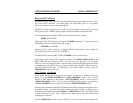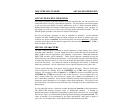
MFJ-1278B MULTI-MODE BASIC OPERATION
Pixtones command serves the same function as the TVBreak command, but in transmitting of
SSTV and FAX pictures.
Printing SSTV Pictures to the Screen
The MFJ-1278B does not support printing graphics to the computer screen without specific
terminal software designed for your particular computer. MFJ offers an optional Starter Pack
(MFJ-1289) which will allow you to receive SSTV and display to the computer screen. The
MFJ Starter Pack software allows for saving SSTV pictures to disk. Pictures saved on disk
may be re-transmitted or recalled to the screen at any time.
When using a terminal program which allows printing of SSTV pictures to the computer
screen, the command PRINTGRA must be turned OFF. MFJ-1278B will send pictures to
the computer screen through the RS-232 port instead of the built-in printer port.
For those who wish to write their own software to handle SSTV printing to the computer
screen, the following information may be useful for you.
When the PRINTGRA is turned OFF, TVX is ON and MFJ-1278B will send free running
raw data thru the RS-232 port. Note that this is not the 4 levels data which is used for
printing to the printer port of the MFJ-1278B. Raw data format is provided so that user can
use special terminal program to achieve more than the 4 levels of gray provided by the MFJ-
1278B firmware. This raw data graphic format is the same for SSTV mode and FAX mode.
Upon hearing the sync tone for SSTV, raw-data stream is sent to the RS-232 port until a
"CTRL-C" is received. For multi- level SSTV and FAX modes, the terminal program is
responsible for attaining synchronization and end-of-picture detection of pictures.
In 8-gray levels the raw multi-level data are packed two pixels-per-byte. To enable ASCII
transparency of the raw data, the MFJ-1278B biases each byte with +30H. On transmit, you
must likewise bias the outgoing data with 30H.
There are two exceptions. If the actual data byte (Before unbiasing) is "p", or "q" then the
1200 Hz Syne tone is being received. "p"means it was receivedin the first time position, "q"
the second.
After unbiasing: bit# 7 6 5 4 3 2 1 0
data x x a a a b b b
x = don't care
a,b=first and second pixel groups


















